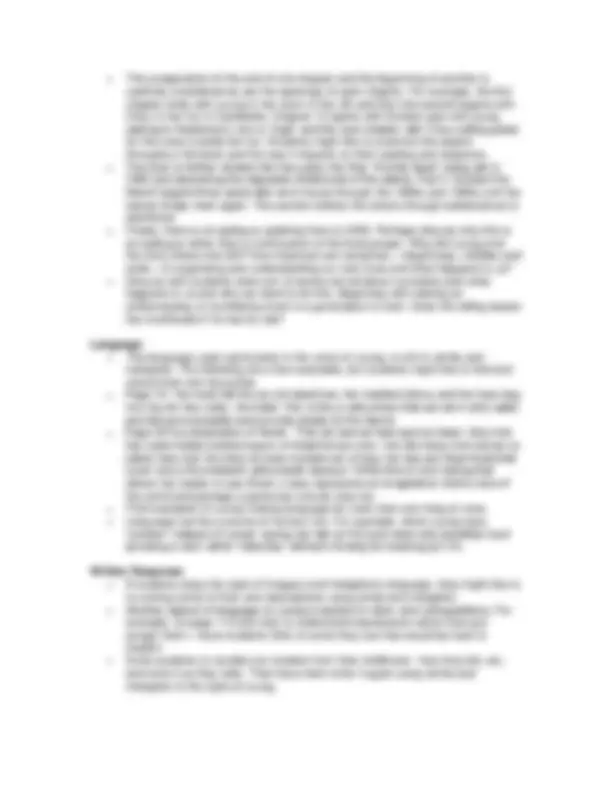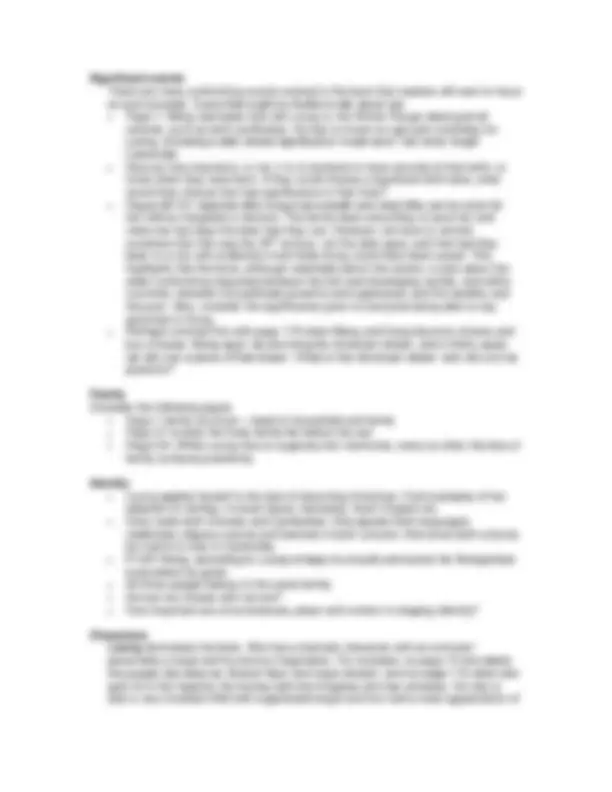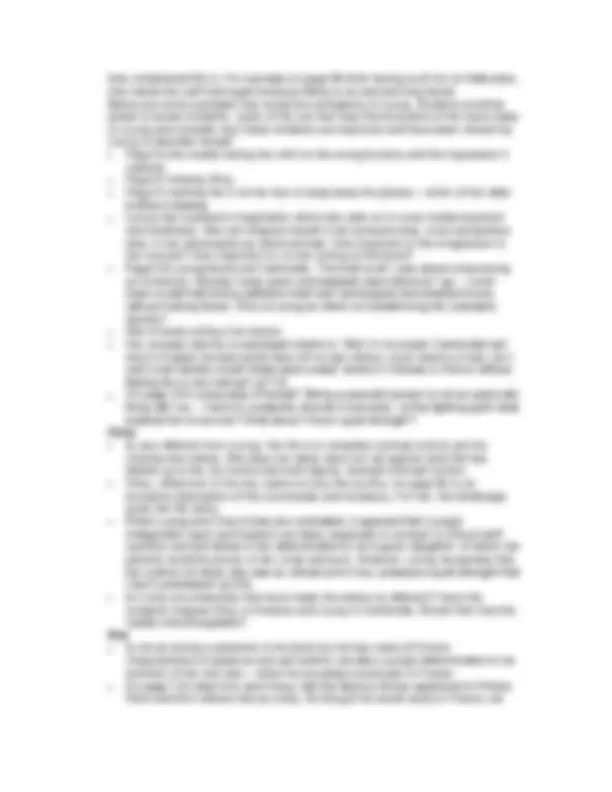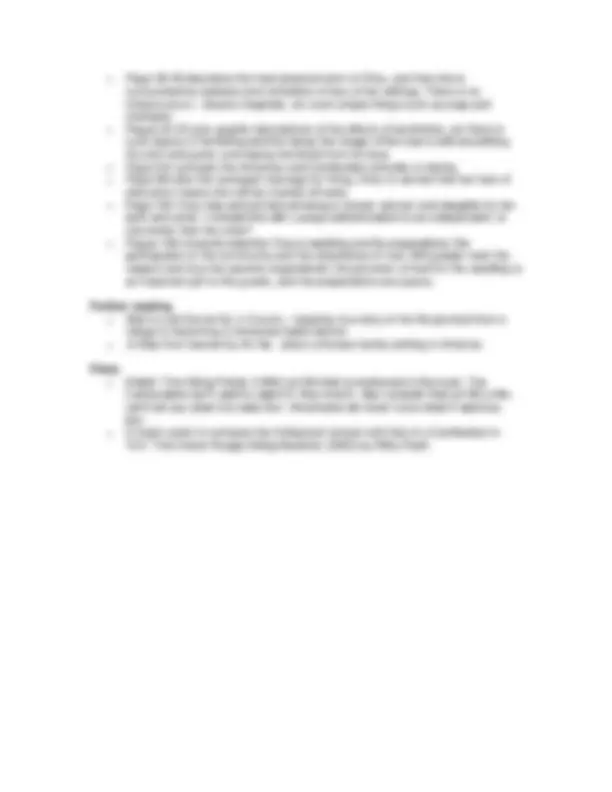






Study with the several resources on Docsity

Earn points by helping other students or get them with a premium plan


Prepare for your exams
Study with the several resources on Docsity

Earn points to download
Earn points by helping other students or get them with a premium plan
Community
Ask the community for help and clear up your study doubts
Discover the best universities in your country according to Docsity users
Free resources
Download our free guides on studying techniques, anxiety management strategies, and thesis advice from Docsity tutors
Lucky Child is a memoir by Loung Ung that continues the story of her family, focusing on her sister Chou, who remained in Cambodia during the Khmer Rouge regime. teachers' notes for using the book in the classroom, discussing its style, themes, and significance. Students need background information about Cambodia's history and the importance of oral tradition and written records in understanding the narrative.
What you will learn
Typology: Exercises
1 / 8

This page cannot be seen from the preview
Don't miss anything!





Teachers’ Notes prepared by Dr Pam MacIntyre
Loung Ung lost her mother and father and two sisters during the terrifying regime of the Khmer Rouge in Cambodia, a story told in her first book First They Killed My Father. Lucky Child continues the story of the remaining members of the family, focussing on Loung, and her sister, Chou. This remarkable story is one not often told. While ten-year- old Loung travelled to America with an older brother and his wife, her best friend and sister, twelve-year-old Chou remained in Cambodia with two remaining brothers, in a small village, learning the skills of survival, and becoming a dutiful „daughter‟ to the aunt and uncle who took her in. Her schooling is interrupted and then abandoned. The contrast between the lives of the two sisters could not be greater. Because of embargoes on contact with Cambodia by the US, the sisters lost contact for five years. Eventually, fifteen years later they meet again. Loung and Chou‟s stories are told in alternating chapters across the span of those fifteen years, from 1980 to 1995. It is an affecting, poignant and powerful story of familial love and inspiring resilience, told with restraint dignity and humour.
Before Reading/Context Setting/Activating repertoire To be able to appreciate and understand the terrors that haunt Loung‟s dreams, and which motivate her decisions and construction of herself in America, as well as the circumstances of Chou, students need some background information about Cambodia‟s history, particularly during the 1970s and 1980s. Brief but shocking and evocative information is presented in the preface, and if First They Killed My Father has not been read, then sections could be chosen to fill in the students‟ background knowledge. Additionally, the list of references at the conclusion of the book could be used for research. Expanding one‟s factual repertoire is one of the pleasures of reading, and activating that knowledge would enhance this reading experience for students.
Biography and Narrative As well as being a rich resource for expanding students‟ knowledge of world events and their personal impact, Lucky Child is a rich resource for appreciation of the construction of narratives and biographies. For instance, Loung outlines the difficulties of writing about a life in which she was not present, that is Chou‟s as well as translating the languages. She acknowledges that it involves interpretation of events, coloured by memory. It is valuable to look at the sources Loung used – and what they reveal about different cultures, and how powerful the written record can be. However, she also values the oral tradition and it is the documents of everyday life that are important in telling these life narratives (pxiv).
Story On many levels this book is all about story. For instance, on pages 96-97 story is all Chou has to offer badly burnt Kung, but nevertheless it is soothing and calming Television narratives have significance for Loung, such as on page 29 when she describes the violent cartoons in which no one is irrevocably hurt or killed, and on page 30 the story Brady family: story as consolation? Fantasy? Buffer against reality? On page 119 Loung and little Maria construct their story together – shared experience and connection between the two.
Style The style in which Loung writes immediately draws in the reader. It might be useful to talk about the choices she has made: it is conversational, first person, with strong visual imagery (consider her description of how she imagines growing up „wrong‟ on page 4) but perhaps what gives it immediacy is the use of the present tense. Perhaps have students rewrite a short section in the past tense to see what the effect is on the story, on the reading experience, and how the reader reacts to it. It is also frank: on page135 Loung expresses her rage and anger at Maria‟s blessed childhood, which is a kind of grief for her lost childhood and the safety that was taken from her.
Use of vivid anecdote Loung has an acute ability to capture small but significant events. A particularly good example is how she prepares herself for America on pages 3 and 4. This incident is not only about washing herself, but is revealing of her personality and intent to annoy. On page 29 when visitors come to the flat in the US and Loung doesn‟t understand the conversation she plays imaginative games in her head. Have students find other examples that they enjoy or consider to be revealing and talk about what makes the writing so vivid and appealing.
Narrative Structure As indicated above, the sisters‟ stories are told in alternating chapters, Loung‟s in the first person, and Chou‟s in the third person. Examine the differences between first and third person, whether this is limiting for an understanding of Chou, and whether it affects the reader and how they react to Loung and Chou.
Significant events There are many confronting events evoked in the book that readers will want to focus on and „process‟. Some that might be fruitful to talk about are: Page 7: Meng estimates how old Loung is: the Khmer Rouge destroyed all records, such as birth certificates. He has to invent an age and a birthday for Loung, choosing a date whose significance „made sure I will never forget Cambodia‟. Discuss how important, or not, it is to students to have records of their birth, to know when they were born. If they could choose a significant birth date, what would they choose that has significance in their lives? Pages 98-101 describe little Kung‟s slow death and what little can be done for her without hospitals or doctors. The family does everything to save her and make her last days the best that they can. However, we have to remind ourselves that this was the 20th^ century, not the dark ages, and that had they been in a city with antibiotics most likely Kung could have been saved. This highlights that the book, although ostensibly about the sisters, is also about the wider confronting inequities between the first and developing worlds, and within countries, between the politically powerful and oppressed, and the wealthy and the poor. Also, consider the significance given to everyone being able to say good bye to Kung. Perhaps contrast this with page 179 when Meng and Eang become citizens and buy a house. Meng says „we are living the American dream, and in thirty years we will own a piece of that dream‟. What is „the American dream‟ and why is it so powerful?
Family Consider the following pages Page 7 family structure – head of household and family Page 37 evokes the lively family life before the war Page134. While Loung tries to suppress her memories, every so often the loss of family surfaces powerfully.
Identity Loung applies herself to the task of becoming American. Find examples of her adoption of clothes, musical tastes, hairstyles, fluent English etc. Chou feels both Chinese and Cambodian. She speaks both languages, celebrates religious events and festivals in both cultures. She loves both cultures but wants to stay in Cambodia. P1367 Meng, according to Loung is happy to proudly announce his „foreignness everywhere he goes‟. All three people belong to the same family. Do/can we choose who we are? How important are circumstances, place and context in shaping identity?
Characters Loung dominates the book. She has a dramatic character with an extrovert personality a large and humorous imagination. For example, on page 10 she labels the people she sees as „chicken face‟ and „pig‟s cheeks‟, and on page 116 when she gets hit in the head by the hockey ball she imagines she has amnesia. Yet she is also a very troubled child with suppressed anger and hurt and a keen appreciation of
how complicated life is. For example on page 89 after having such fun at Halloween, she makes her self hard again because Meng is so sad and long-faced. Below are some examples that reveal the complexity of Loung. Students could be asked to locate incidents - parts of the text that they find evocative of the many sides to Loung and consider why these incidents are important and have been chosen by Loung to describe herself: Page10 she recalls having her shirt on the wrong buttons and the impression it created.. Page12 missing Chou Page14 marking the X on her foot to keep away the ghosts – victim of her older brother‟s teasing. Loung has a powerful imagination which she calls on to cover embarrassment and loneliness. She can imagine herself to be someone else, or be somewhere else, or her adversaries as weird animals. How important is this imagination to her survival? How important is it to her writing of this book? Page120 Loung blocks out Cambodia: „The truth is all I care about is becoming an American. Already I wear jeans and baseball caps wherever I go…I even make myself eat boring cafeteria meat loaf, hamburgers and shepherd‟s pie without making faces‟. Why is Loung so intent on transforming her (outward) identity? She is lonely without her sisters. Her complex identity is expressed clearly in :„But I‟m no proper Cambodian girl. And in English the bad words blow off my lips without much shame or fear, yet I can‟t even silently mouth these same swear words in Chinese or Khmer without feeling like a very bad girl‟ (p110) On page 234 Loung says of herself :‟Being a peaceful person is not an automatic thing with me…I have to constantly choose it everyday‟. Is this fighting spirit what enabled her to survive? What about Chou‟s „quiet strength‟? Chou Is very different from Loung. Her life is in complete contrast and so are the choices she makes. She does not rebel, does not rail against what life has dished up to her, but works hard with dignity, strength and self control. Chou, while born in the city, learns to love the country: on page 85 is an evocative description of the countryside and its beauty. For her, the landscape gives her life value. When Loung and Chou‟s lives are contrasted, it appears that Loung‟s independent spirit and freedom are ideal, especially in contrast to Chou‟s self- sacrifice and self-denial in her determination to be a good „daughter‟ of whom her parents would be proud, to her uncle and aunt. However, Loung recognises that her mother (of whom she was so critical) and Chou „possess a quiet strength that I don‟t understand‟ (p233). Is it only circumstances that have made the sisters so different? Have the students imagine Chou in America and Loung in Cambodia. Would their lives be readily interchangeable? Kim Is not as strong a presence in the book but he has many of Chou‟s characteristics of patience and self-control, but also Loung‟s determination to be architect of her own fate – which he actualises eventually in France. On page 129 when Kim and Khouy visit the family‟s former apartment in Phnom Penh and Kim reflects that as a boy, he thought he would study in France, we
School Loung‟s early experiences at school reveal how her expectations do not match a harsher reality: Page 67 she wants friends who are not Asian, not different. She is excited imagining her new friends but that is not what happens. We all need to feel we fit in, don‟t we? Page 73 documents her difficulties in making friends in America because she doesn‟t know how to be funny in America or English Page 74 „Even though Tommy and I rarely spoke, I felt tied to him in our Asian- ness‟. What does she mean? Do you understand how she feels? Page 93 describes the physical and intellectual toll: „It takes so much energy, work, and effort to listen, understand, talk, study, learn, and remember everything in class that I often go off by myself during recess to be quiet‟. There are also examples of incidental, but no less hurtful racial prejudice, such as on page112 when the boys laugh and turn their heads away.
Sections for discussion: Page 77 ‟In my mind the war rages on, even though I know I live in a peaceful land.‟ Page 94 Loung doesn‟t fit in America but she doesn‟t want to go back to war – she has become too soft and doesn‟t even want to join Chou. Are comfort and safety more important than happiness and family? Ask students what they think. Page 74 „In one another‟s company, the adults speak easily in Khmer, shed their shy and unsure refugee skins, and change into funny, confidant, and vibrant individuals.‟ Page 276: why is Loung afraid to go back to Cambodia? What is she afraid of? Page 284 America is Loung‟s home „for the moment [but] Cambodia will always be in my heart and soul‟. How can home be in one place and heart and soul in another? Page 235: „There‟s no “their world” and “your world”, Mike. There‟s only our world.‟ Page 265: Loung realises that her choices of „…living life to the fullest, of not missing a single moment, and making every minute count had been all about me and had involved only me…I know that…living life to the fullest involves living it with your family‟.
Culture and community The book highlights how different cultural communities, events, conventions and ways of looking at the world shape us as human beings: Pages 21-22 describe Chou‟s remote village, the lack of communication from the centre, and the constant fear of attack. Page 27 describes the insulting visit from the well-meaning American, who shows her own ignorance by treating the family as ignorant, rather than as the cultured people they were before surviving as refugees. Do you think this is a common assumption made about refugees? Page 28: is it an obligation to feel gratitude? Contrast this with the issues of respect and gratitude for Chou (p39). Page 3: the family meets the McNultys, an Irish/Italian family with an adopted Korean daughter, Ahn – an example of successful cultural acceptance.
Page 38-39 describes the hard physical work of Chou, and that she is surrounded by sadness and reminders of loss of her siblings. There is no infrastructure – doctors hospitals, nor even simple things such as soap and shampoo. Pages 42-43 give graphic descriptions of the effects of landmines, yet there is such dignity in the telling and the dying: the image of the man‟s wife smoothing his shirt and pants, and wiping the blood from his face. Page154 contrasts the American and Cambodian attitudes to dating Page168 after the arranged marriage for Hong, Chou is worried that her lack of education means she will be married off early. Page.184 Chou has worked hard at being a „proper woman‟ and daughter to her aunt and uncle. Contrast this with Loung‟s determination to be independent. Is one better than the other? Pages 188 onwards describe Chou‟s wedding and its preparations; the participation of the community and the attendance of over 400 people mark the respect and love her parents engendered; the provision of food for the wedding is an important gift to the guests, and the preparations are joyous.
Further reading Mao’s Last Dancer by Li Cunxin – inspiring true story of his life plucked from a village to becoming a renowned ballet dancer. A Step from heaven by An Na - about a Korean family settling in America
Films Watch „The Killing Fields‟ (1984) (p136) that is mentioned in the book. The Cambodians don‟t want to watch it, they lived it. Also consider that (p138) a film can‟t tell you what it is really like: „Americans will never know what it was truly like‟. It might useful to compare the Hollywood version with that of a Cambodian in „S21: The Khmer Rouge Killing Machine‟ (2003) by Rithy Panh.